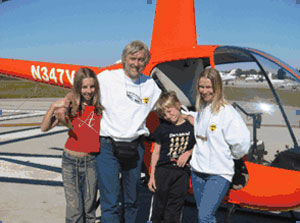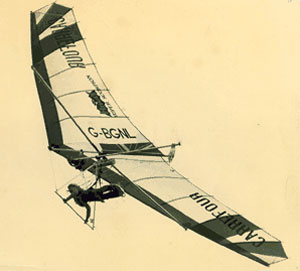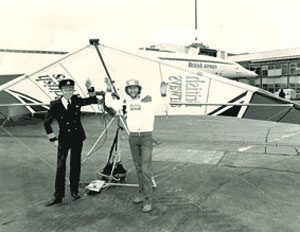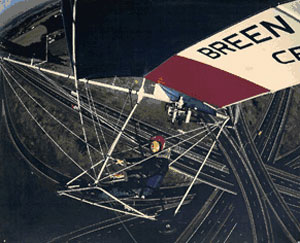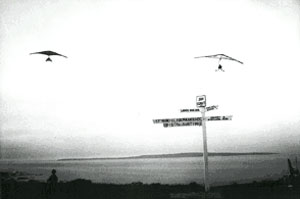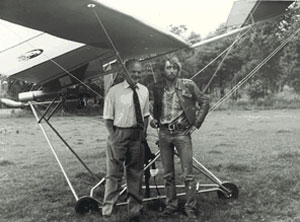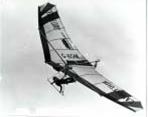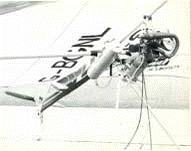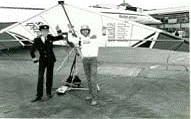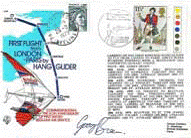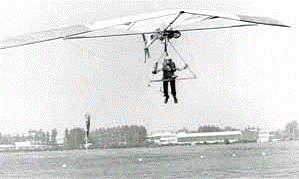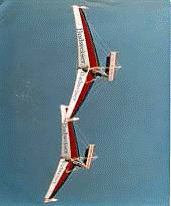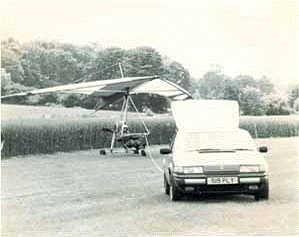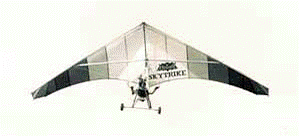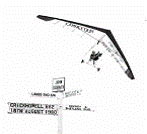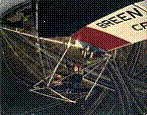Gerry started his long aviation career when only 13 years old at the Bristol & Gloucester Gliding Club.
He joined the Royal Air Force (RAF) at 16 years of age and, during his engineering apprenticeship at the No.1 School of Aircraft Technical Training Halton, he became a gliding instructor at the prestigious RAFGSA Centre, Bicester when only at 17 years of age.
In 1971 he won the Whitbread Bursary Award & Sir Phillip Sassoon Flying Scholarship that started him on his professional aviation career at the Airline Service Training School in Perth, Scotland.
1972 saw him become one of the first people in the UK to successfully fly a hang glider.
He was sponsored by the RAF to set many records including the first Royal Mail to be carried by a hang glider and the first dual flight from the summit of Snowdon.
He along with Sqn Ldr Dave Willis were the first people to hang glide from the summit of Ben Nevis (4,406ft), Britain’s highest mountain, and he held the British and European duration record several times.
In 1974 he left the RAF and set up a hang glider manufacturing company.
He then started the Welsh Hang Gliding Centres at Crickhowell and Ruthin, which became Britain’s largest and most successful schools.
In 1975 he co-authored the first British book about hang gliding with the late President of the BMAA Ann Welch.
1975 and Gerry was the first to take a dual flight from the top of Mt Snowdon
In 1976 he introduced powered hang glider flying to the UK and, by 1978, he had doubled the world non-stop distance record previously held by an American
In 1976 he introduced powered hang glider flying to the UK with his kingpost mounted M’Culloch powered hang glider and, by 1978, he had doubled the world non-stop powered hang glider distance record previously held by an American (John Moody) by flying 202 miles from Tredegar in Wales to Norwich Airport
Gerry's World Distance Record flying the first UK microlight
He went on to become the first person to fly from London to Paris in the British Airways powered hang glider, which was the first Civil Aviation Authority (CAA) registered microlight in the UK (G-BGNL) and the first microlight flight to carry Royal Mail.
A young Gerry prepares to race Concorde to Paris
He was undoubtedly the first person to coin the word ‘microlight'.
Not much traffic on the roads in 1980! - photo taken for Sunday Times Magazine
From 1978 to 1984 he popularised the sport in the media through Breen Aviation (then Britains largest centre) at Enstone Aerodrome so effectively that he became regarded by many as the ‘father’ of microlight aviation.
Gerry wins the Lands End to John O’Groats race in 1980
Gerry & the famous fighter pilot the late Sir Douglas Bader in 1981
Gerry has taken part in many films and television documentaries. They range from flying as a stunt pilot to training pilots for a James Bond film.
The most well known were: `Iceland Breakthrough’ featured in the National Geographic Magazine in which he flew a microlight across the Icelandic wasteland
and `On Angels Wings’ where he and his late great friend Kelvin Wilson were the first people to fly hang gliders from the summit of Angel Falls, the worlds highest waterfall (3000 ft), in Venezuela.
In 1983 he was the personal instructor to His Royal Highness the King Abdullah of Jordan who purchase the ill-fated Pathfinder 2 but did not attempt to fly it due to Gerry’s intervention after he lost two good friends in the aircraft during the French Grand Prix. The aircraft was eventually grounded by the Authorities after more fatalities.
and in 1984 he set up a microlight school in Germany where he met his late wife Manuela. In 1985 he and Manuela moved to the Algarve.
Gerry is the Chief Flying Instructor (CFI) teaching both weightshift and three axis microlights, and aerobatics in his Acrosport biplane. He also flies helicopters, seaplanes, autogyros, sailplanes, hang gliders and paragliders.
He has now amassed nearly 16,000 hours flying experience on more than 200 aircraft types
He is a CAA Panel Examiner, CAA Flying Instructor Examiner (FIE), Senior British Microlight Aircraft Association (BMAA) and Popular Flying Association (PFA) Inspector and Britain's only Microlight Seaplane Instructor and Examiner. He is undoubtedly one of the world’s most able and distinguished microlight pilots.
Copyright Gerry Breen 2008
........................................................
The first 2 Chapters from a book Gerry was writing
From Frank Tarjanyi
Microlighting
Part 1-The Early Years
By Gerry Breen
Dedicated to all the pioneers of microlighting, some have moved on and are no longer with us.
10.35am 17 December 1903, Kill Devil Hills, Kittyhawk, North Carolina. Those two brothers Wilbur and Orville Wright were about to make the most significant step in aviation history and probably didn't realise it!
I now wish when I got involved in hang gliding, or sky sailing as some of us called it, that I’d taken the time to keep a more detailed diary, so that writing this article would be easier!
I often felt like we were stepping into uncharted territory, not as much in the dark as the Wright’s but equally dangerous. Like those two brothers, we flew and understood gliders beforehand, so if there had been no hang gliding I believe there would have been no microlighting!
Even if we had had the technology and knowledge to design and build a microlight in the early 70’s, the legislation of the time would have required it to have an airworthiness document. The paperwork involved would have stopped microlight flying before it even started! However, hang gliders, like sailplanes, were not directly under CAA control because they weren’t powered, so when the opportunity presented itself we opened the door, just a little, fitted tiny engines, and used them ‘to get to the thermals’ and see if the CAA did anything to stop us!
Powered hang gliding had been unsuccessful prior to 1976 because three basic elements were unrefined:
1. Wings were simple Rogallo kite designs of poor performance
2. Small engine technology was crude and unreliable
3. Piloting skills and experience were limited
In 1973, Australian, Bill Bennett, who was one of the most skilled pilots of the era and largest US hang glider manufacturer, built a McCulloch engine unit that drove a small caged propeller that when strapped to the pilot’s back pushed him along. In practice when used with the best hang glider of the day, it was nothing more than a glide extender. The engine needed constant tuning and was unreliable. I heard rumours that it was more regularly used on bicycles and roller skates down Santa Monica Boulevard than on hang gliders!
Bennett Back Pack
1976
Designers were once again developing high aspect ratio, low billow, cambered sail wings (previously tried in 1973 with some disastrous results). This time however we knew more about sail design, structural integrity, control and stability. This led to improved glide ratios, which meant less drag and therefore less power.
Lightweight, high-powered, two-stroke engines were becoming more reliable due in part to better oil technology and improved carburettors.
Pilots were developing their skills to such an extent that they no longer considered it normal to crash each time they flew, especially as pilots could obtain training. Therefore, by the start of 1977, it was inevitable that powered hang gliding would start to grow.
The only unanswered questions were where to fit the engine, the size of the propeller and how it was driven.
I yearned for the ability to takeoff and fly wherever I wanted. In 1974 Roger Kendis, an American hang glider friend, had sent me some photos and film of him using the Bennett backpack. The film showed him soaring with it in California. The thing was so inefficient that even when used with a Quicksilver ‘high performance’ hang glider designed by my late friend, Bob Lovejoy, it just about managed level flight. And Roger wanted us to cross the English Channel with them in 1975!
However, the seed had been sown and, like several others at the time, I saw the future! In 1975 I telephoned Bill Bennett and asked him for one of his backpacks. He was reluctant to supply me with one having shelved the project because, he said, that it was too experimental. “I want to experiment,” I pleaded but he wouldn’t budge. So I found a McCulloch engine in the UK, which sat around my hang glider workshop in Crickhowell for a while until 1976, one of my hang glider students who built model aircraft, reckoned he could help me build one.
The backpack idea was ditched as we both concluded from the picture that it wouldn’t develop enough thrust. We decided on a much larger propeller and toothed-belt reduction-drive (something, which to our knowledge hadn’t been tried before). We fitted the unit above the best performance wing and I flew it from a hill without the engine running. It was top heavy and just balancing the glider on my shoulders was an art in itself. With the engine running I managed to climb but was unable to apply full power as I had reached the limit of forward bar travel. Additionally any gust, which dropped the nose, would have required an immediate reduction in throttle or I felt that the glider would have tucked. I landed with very tired arms, feeling I could resolve the problem by flying prone, which I knew would give me more forward bar travel.
Roger with Quicksilver and Backpack – note his handwritten suggestion below!
The Cronkite high aspect ratio hang glider in 1973
I then took off on the gentle, nursery slopes at Sirhowy Common in Wales. I started the takeoff run and applied the hand throttle, probably just a little too aggressively. Just as I was taking off, a gust dropped the nose and I didn’t reduce the power quick enough. I stumbled and fell. The base bar hit the ground and I shot forwards through the control frame. The engine and kingpost unit continued straight ahead, the rear upper rigging wire snapped and the whole lot crashed through the front of the wing and very nearly decapitated me! Back to the drawing board!
It is interesting to note that Wings Editor, Nick Regan, gave good advice in the December 1976 issue: “those thinking about experimenting with power should obtain a publication about Breeza Ducted Fans from Cyclone Hovercraft at Bedford”. 10 years later Cyclone Hovercraft became the biggest supplier of engines for microlights in the UK.
1977
Murray Rose and Simon Wooton of Chargus Hang Gliders, Buckingham had fitted a McCulloch engine unit under the keel of a Midas hang glider. The engine revved to over 6000 rpm and therefore they had to keep the direct drive propeller a relatively small 24 inches diameter. They did very well with it, even doing an air display at Shoreham, but the programme seemed to fizzle out. According to Wings Magazine in the July 1977 edition “they were awaiting a decision from the CAA in order to carry on with development”. And we’re still waiting!
David Cook and Neil Moran fitted a McCulloch engine onto a VJ 23 high performance, rigid wing, hang glider. They admitted that their engine unit had insufficient power to keep their aircraft airborne in still conditions. I saw him demonstrate it on several early occasions and I reckon he only got airborne due to ground effect and only climbed because of the earth’s curvature!
Steve Hunt experimented by fitting a Scorpion with a McCulloch engine driving a ducted fan via a reduction gear unit, but he stopped development because it was too heavy. However, he visualised the need for a clutch unit to facilitate starting and to reduce shock loading on the drive system. I always wondered why he didn’t fit one on future models.
Nick Lawler was flying a Falcon 4 powered by a Victor 170cc lawn mower engine, which had insufficient power to maintain height in no lift conditions. However the lawn mower engine on a hang glider image lives with us to this day so you could say he started something!
Simon Wooton prepares for takeoff on Midas
Steve Hunt left, with the ducted fan in 1977
Len Gabriels experimented with two 10cc model aircraft engines and then fitted a McCulloch engine with a reduction system and long driveshaft. His was one of the few units to develop ample thrust and put him at the forefront of development.
The conclusions reached by most of us at the end of 1977 was that the thrust line should be as low as possible, preferably below the keel on flexible wing hang gliders; propellers should be as large as practical and the rotation speed as slow as possible. The whole concept was more complicated than we first thought.
During the first Powered Hang Gliding Conference near Buckingham on 18 August 1977, the late President of the BMAA, Ann Welch spoke of her desire to see control over powered hang gliders being kept within the BHGA. The meeting also decided on a maximum empty weight of 70 kilograms and interestingly, one of the proposals was that the aircraft should be unable to take off under it’s own power! In other words it was a self-sustaining ‘getting to the thermals’ unit only. I knew that we were in for future battles, as many members of the BHGA didn’t want anything to do with powered hang gliders. The BHGA therefore, decided to form a powered hang gliding committee in order to look after pilot’s interests.
Meanwhile powered flight was progressing in the USA and in October I went to stay with one of the rigid wing experts, Trip Mellinger, who had just successfully flown his Easyriser biplane, powered hang glider from mainland California to Catalina Island some 26 miles away! Trip was more than helpful, even letting me have a go in his new toy! I found the aircraft cumbersome on takeoff and with its low powered, high revving direct drive propeller was extremely noisy, even with earplugs! He promised to let me know of any new developments for powering flexible wing hang gliders and, true to his word, he contacted me in November with details of a company called Soarmaster in Scottsdale, Arizona. They had developed a Chrysler two stroke engine unit with splash box lubricated chain reduction system, clutch and long drive-shaft that bolted below the keel hang glider keel. It developed around 10 hp and gave about 80 pounds of thrust. The promotional pictures showed pilots getting airborne from level ground with apparent ease. They failed to show the windsock at the time of takeoff! The unit was recommended for fitting on an Electra Flyer Cirrus or Olympus hang glider, as the mounting brackets and thrust line calculations had been done for these two gliders only. I already owned an Olympus so I ordered a Soarmaster immediately.
Len Gabriels prepares for takeoff – note the thrustline is parallel to keel
Gerry taking off on Olympus 180/Soarmaster 1978
1978
I remember the day in February when it arrived. The manufacturer’s advice was to run the engine in properly and then fly from a hill with the motor stopped. I sensibly heeded their advice and then headed off to Abertysswg near Tredegar where a smooth soarable westerly wind was blowing gently up the slope.
I knew all about thrust and drag lines by then and saw they had designed the mounting brackets to give the wing a good positive angle of attack when power was applied. The handling without power was excellent so I started the engine, put the throttle peg in my mouth and took off. Once established in the rising air I gradually opened up the throttle. To my surprise the bar only needed slight forward pressure even when I plucked up the courage to give it full power. I was at 2000 feet and the climb rate was looking to be at least the 200-foot per minute claimed. At only 20mph airspeed this was quite a steep angle of climb. Whoopee! This was magic, everything I hoped for and more!
I landed back on top of the hill but realised the local club pilots were not as excited as I was. Mumblings about noise and pollution on ‘their’ site made me realise that I needed to try flatland operations. The first was into a 10knot wind and after only a few steps I was airborne. The problem came in light winds. A fine balance existed between applying too much power, causing the aircraft to overtake you or not enough power and running across the field until exhausted!
I thought initially that the ‘peg’ in the mouth throttle (you were careful whom you shared it with and your teeth chattered continually with the vibration!) was very crude, even laughable and was only required because both hands were occupied during takeoff. I was even tempted to ditch it for a hand throttle until I realised its importance during my very next flight when I encountered rotor behind the Blorenge Mountain. The nose pitched down violently and I floated away from the control bar towards the keel in a zero ‘G’ situation and I uttered the words: Oh Sh..! The ‘Oh’ did the trick as the peg fell out of my mouth and shut the throttle!
Ideal conditions for foot launched takeoff usually meant stronger winds aloft and with a maximum flying speed of around 30 mph this meant that cross country flights were usually downwind!
The fuel tank held half a US gallon and was good for only about 20 minutes flying, so I had a lightweight one made to hold two gallons. Now I could really go places and in April flew my longest flight to date from Crickhowell to the gliding club at Usk. I remember landing to the amazement of the club members. They were sceptical as to whether one could actually take off again and I was out to prove them wrong! When I came to take off, the wind was virtually calm, the worst conditions and I also had the extra weight of the larger tank. I convinced myself that I could run fast enough! Now again hindsight is a wonderful thing - I should have known that the second powered hang glider accident in the UK was about to happen and I couldn’t miss that! The machine got away from me; I stumbled and fell, bit the throttle for all it was worth and pushed the bar forwards in the fully prone position as hard and as far as I could. The control frame brushed the grass then came to an abrupt halt as it dug in and I ‘flew’ forwards through the control frame into the wing. I picked myself up but couldn't stand properly. I felt numbness in my right foot and looked down to discover the end of my right shoe missing. I hobbled back to find it with my toes safely tucked inside!
In a hospital specialising in burns and amputations, they managed to successfully pin and stitch three toes back on and, thankfully, my big toe was still attached. I remember being in a ward with people who were much worse off. The bloke in the next bed turned to me and said, pointing at my foot, “hover mower” to which I replied “no, powered hang glider” he laughed at my ‘joke’! To add insult to injury I received a letter in hospital from Soarmaster warning: “all power unit operators should either cease flying or call the manufacturers to discuss proper flying technique, as there have been injuries to feet through contact with the propeller due to incorrect flying technique.” The problem mainly applied to pilots over 5 feet 9 inches tall and I am 5 feet 11 inches – a good thing I wasn’t much taller!
Over the next few weeks I learned to walk and run once more and, six weeks later I was flying again but was a much wiser pilot! I had a safety strap connecting the control frame to my harness, which prevented me from getting too close to that propeller even if I let go of the control frame.
I was understandably very apprehensive about taking off in light winds from then on. I fitted small wheels to the control frame and the tail but lack of directional control on the ground made it almost impossible to take off with any degree of control. Therefore, I developed a special roof rack for my Range Rover. I would lift the aircraft onto it, harness myself in and lie in the prone position with the throttle peg in my mouth. My driver (virtually anyone who could follow the brief!) would drive at a steady 25 mph and I would simply release the nose catch and float off skywards.
Sadly, the first recorded fatality was in June at Wittenham Clumps near Oxford. Nick Lawler had bought a Soarmaster from the States and fitted it to his Wasp hang glider – not approved for the unit. One of the conclusions was that the thrust line and the torque effect were contributing factors in the turbulent conditions. Also, according to witnesses, the power was not reduced when the aircraft pitched down at low altitude.
David Cook carried on with his development of the VJ23 and made some remarkable flights not least being the first flight across the English Channel on 9 May 1978.
Despite there being a powered hang gliding Committee within the BHGA there were those that resented powered flight. The final straw for me came when a letter was published without my knowledge in the Wings magazine stating that the CAA intended prosecuting me for various offences on a powered hang glider. I felt like I was going to be made a scapegoat and it was time to engineer a split from the Association. A friend of mine, Jonny Seccombe, wrote a letter of condemnation, published in the September 1978 issue, which had great foresight: “If the BHGA is to ensure that there is no place for powered hang gliding within its organisation, then powered pilots will inevitably form their own”.
I met up with Jonny and we decided to propose the formation of the British Powered Hang Gliding Club to the BHGA. At a meeting of the BHGA Council on 1 October 1978 they agreed but still under their control! All those involved in powered flight were invited to the inaugural meeting of the new club at the Welsh Hang Gliding Centre on the 28 October 1978 and I still have the minutes of that meeting. Those present were, myself, Jonny, Steve Hunt, Ashley Doubtfire, John Long and Roy Beckett. The next meeting was scheduled for 26 November. However, before the next meeting, something happened which scared us all.
On 13 November the BBC filmed Brian Milton flying the Len Gabriels designed Skyhook Safari powered hang glider. During the flight, Brian tucked, the wing folded, plummeted to earth, and the whole thing was aired on prime time television. I watched the film several times and have the accident report. The combination of turbulence, incorrect thrust-line and the failure to reduce power quickly enough when the nose dropped were contributing factors in the accident. Although seriously injured, the relatively slow vertical decent and the fact that Brian fell into a ploughed field undoubtedly saved his life.
Ashley Doubtfire asked me to set up a Soarmaster unit on his Moonraker hang glider. During testing, however, one of the GRP propeller blades broke off in flight causing massive vibration. I managed to get down safely.
Gerry makes first flight on Olympus with Soarmaster – Holland, November 1978
It seemed that although myself, David Cook, Jimmy Potts (who flew the Irish Channel in June 1979) and John Long were doing a lot through our displays to better its public image, powered hang gliding was still seen as noisy, daredevil stuff.
My favourite movie has always been Those Magnificent Men in their Flying Machines and I dreamed of re-enacting the flight. I felt that one day there would be an annual London to Paris Air Race and I wanted to give it a try whilst our aircraft were still in their infancy.
I told Steve Hunt in confidence of my intention to fly to Paris and he said quite rightly that I shouldn’t do it on an American aircraft! He set about building a power unit for my Super Scorpion Hang Glider. Using my old McCulloch motor from the kingpost design, he came up with his version of the Soarmaster. It developed slightly more power and used a reduction belt drive system, but had no clutch. The unit, including glider, was considerably heavier than the Soarmaster and Olympus combination but the wing was much more robust.
I contacted the French authorities and they agreed that I could enter their airspace providing that the aircraft was on the UK register and I carried a transponder for the channel crossing. They eventually yielded on the requirement for a transponder provided I wore a lifejacket, wetsuit and had boat or helicopter support.
I applied for aircraft registration and was initially refused. In the meantime I marked out and drove the route to Paris, introducing myself to the authorities at each stage and gaining permission to operate from their aerodromes.
1979
After several months of persistence including help from the RAF Museum (it was arranged to carry Royal Mail, First Day Covers during the flight) I finally achieved success, receiving the first UK Certificate of Registration of Aircraft for my Super Scorpion Powered Hang Glider G-BGNL on 4 April 1979. I was now ready and planned to takeoff in early May.
I had sent out lots of letters to potential sponsors and received a very positive reply from British Airways! They would agree to sponsor me for the London to Paris flight continuing on a yearly renewable contract. The problem however, was that they wanted me to postpone my May flight until August 1979 to coincide with the 60th Anniversary of
Gerry’s Hiway Super Scorpion with Steve Hunt’s power unit
Commercial Flight. Should I wait that long and risk someone else beating me, or should I go as soon as the weather was reliable? I decided that having such a high profile sponsorship deal was worth the wait.
Could I keep my plans secret long enough? Could I do something else in the meantime?
1979 - To be continued…
Gerry flying the Super Scorpion and Steve Hunt’s power unit – note the thrust line
............................................................................................................
Microlighting
Part 2 The Early Year s
By Gerry Breen
1979 continues
Whist awaiting the August deadline for the London to Paris flight I decided to have a crack at the World distance record for powered hang gliders using the Carrefour sponsored machine. I had heard that Larry Mauro in America had done 101 miles on an Easyriser and I was confident that I could beat it. My longest flight to date had been 52 miles from Wells in Somerset to the Hunt’s home in Wales. I had only done this as a last minute adventure after giving an air display in Wells. To my knowledge this was also the longest flight on a powered hang glider in the UK at the time.
The attempt was on Wednesday 18th April 1979 from the Wrekin hill near Shrewsbury. I had cut a map into a long strip that was put on a roller, which during the flight I could unwind as the journey progressed. The flight started off well but after about 90 miles I experienced severe vibration, which caused various nuts and bolts to fall away from the power unit, resulting eventually in a drive shaft failure. I landed next to the motorway at Thorne near Scunthorpe having covered exactly 98 miles - just 3 miles short of the record. With the experiences gained, Steve and I reinforced the drive shaft, wire-locked and applied Locktite to just about anything that risked coming undone. I reckoned at the time that we needed a clutch unit to remove the shock loadings on the drive shaft but this would have meant a complete redesign of the system.
At 11.19 on the morning of Monday 7th May I departed Abertysswg, South Wales heading for a declared goal of Norwich Airport, a distance of 202 miles. After about 50 miles the engine, which had been tuned at takeoff, started to run rough and I realised that it might soon stop if I didn’t retune it. The only way that I could get to the carburettor involved an idea that I had never put into practice before. I came out of the prone position, transferred from the hand to the mouth throttle and climbed up into the control frame to retune it whilst simultaneously keeping control by moving my weight inside the frame.
The Super Scorpion power unit and extra fuel tanks
Steve and I had agreed that he would drive to Sywell Aerodrome and, if he saw me fly overhead, he would then continue the long road journey to Norwich. He later told me that as I passed overhead the wind was 25 kts gusting 35 kts and a helicopter pilot had said that nothing was flying that day! Arriving at Norwich Airport boundary after a flight of almost 4 hours, I ran out of fuel and landed just short of the tower and the assembled media. I was given permission to takeoff again so that the television cameras could re-film the landing. As I had flown ahead of a fast moving frontal system the weather was now deteriorating, becoming very gusty and raining. I settled for a quick takeoff, short hair-raising flight and a quick landing. The flight was headline news being featured on all the news stations that evening and newspapers the next day. However, Steve and I realised that we had little chance of capitalising on it as the aircraft was just too difficult to fly and, therefore we could not sell them to the general public.
Spurred on by the success of the flight, I set about planning the finer details of the London to Paris flight. I had heard a rumour that Len Gabriels and Brian Milton were also going to attempt it and hoped that they would not be ready until after my planned start date. Hiway Hang Gliders built me a beautiful Super Scorpion wing with the British Airways design incorporated into it.
In late July, Steve and I visited Oshkosh, USA for the annual EAA meet to catch up on the latest developments in the ultralight scene. There was a crude array of powered hang gliders on show and we reckoned that our powered Super Scorpion would have given them all a run for their money. I went to Rhode Island in order to get some training before attempting to fly my new autogyro when I got back. I was taught to fly on a towed gyro glider, which proved to be an invaluable experience and inspired me to use this method in order to teach people to fly the Eagle in the following year.
Upon my return I continued flying my autogyro. It was after experiencing severe vibration, virtually losing control, plummeting to the ground and landing extremely heavily that I discovered that the wooden and glass-fibre blades had started to warp and delaminate. This required a new set of blades – quite an expense at the time. Then I had a thought - why didn’t I try to fit a large reinforced hang glider to the remaining undercarriage frame and engine instead. Excited, I explained my concept to Steve. He seemed unimpressed with the idea and indicated that he felt the powered hang glider had a limited future and his efforts would be concentrated in the development of a proper three axis aircraft.
For the London to Paris flight I wanted to take off at the departure site of the original first commercial flight – Hendon, but the area had too much congestion. Concerned about the relative unreliability of the unit and the bits that kept falling off, I wanted a wide-open space south of London so opted for Biggin Hill, technically not the City but did it matter? Departing Biggin Hill on 25th August, I arrived 1hr 50 minutes later at the old wartime airfield of Hawkinge. However, I discovered that the drive shaft had again fractured around the propeller bolt-hole. As the shaft extended well beyond the last bearing, I simply sawed it off and drilled a new propeller-mounting hole. I calculated how much time the engine had run since the last fracture and reckoned it would see me across the English Channel.
Gerry poses in front of Concorde
The next leg of the journey, to Le Touquet, was therefore the most worrying. The RAF had unofficially said, that if they happened to be in the area and were not on call-out, they might accompany me. Brian Gaskin was acting as surface support but the seas were so rough that I quickly left him and his boat behind. I was feeling very vulnerable when a bolt (from the exhaust pipe, I later found out) landed on my map holder. Fear set in as I wondered if I might have to put down in the sea then suddenly a Wessex helicopter came into view. The crewman waved from the open doorway and this gave me an immense feeling of relief. I made Le Touquet without further mishap in 48 minutes and, after an overnight stop, I was getting ready for departure when I encountered engine problems and I was also told the news that I was being chased by Len Gabriels in the Bluebird Toffee-sponsored Skyhook Safari. Unfortunately this was turning into the race I didn’t want and I wasn’t going to be beaten after all this effort. I got no further than a few miles en route when the drive shaft failed yet again and I forced landed in a cornfield at Conchet Le Temple.
The first Royal Mail to be carried by powered hang glider
I was really distraught and fully expected to be overtaken at any moment. I managed to get it repaired, by a local blacksmith who was also a pilot, and was soon taking off for Abbeville. After refuelling quickly I continued on to Beauvais even though it was quite late and the forecast was bad. I was delayed by a severe thunderstorm and, therefore, arrived in the dark; elated, knowing that it would be difficult to catch me now that I had flown so far in one day. The next morning, I departed and was met at St Cyr 1 hour 40 minutes later by a large crowd. British Airways and the RAF Museum had pulled out all the stops on their massive publicity machine. The flight was covered by most of the news channels and was the front cover story of most of the daily newspapers. On arrival in France, and unknown to me at the time, Len had initially been grounded at Le Touquet and again later, 65 miles north of Paris, because they said he had not obtained the required authorizations.
Gerry arrives at St Cyr near Paris
Powered Hang Gliding continued to grow and the British Powered Hang Gliding Club had now been in existence for nearly a year. There were many exciting things happening with powered hang gliders and ultralights. Quite a few people had made their own engine units. Rob Jakeway had a Vega 1 with a direct drive unit and was making a Suzuki engined unit for a Super Scorpion. Paul Baker, David Garrison and David Kirke returned from the USA with Pterodactyl’s, (Fledgling hang glider conversions) which had tricycle undercarriages so that foot launching was no longer the only option.
The increased publicity and gain in popularity led to concern by the BHGA that the CAA would legislate all activities including hang gliding. The BHGA wrote to the CAA asking for clarification of the legal situation. Their reply stated that powered hang-gliders were aeroplanes and as such pilots should hold licences; the machines should be registered and have certificates of airworthiness or permits to fly. None of these requirements were being satisfied and the situation needed regularising. However the requirements would not be imposed provided the aeroplane’s weight, including engine and fuel, did not exceed 50 kg. This weight was selected as being a reasonable maximum for a machine, which a person could launch without the aid of some form of under-carriage, and would encompass all existing types of powered hang-gliders. Should mini-aeroplanes above that weight come on the scene, it would be open to the Authority either to apply existing requirements or to deal with them by exemption or by developing specific requirements as appropriate.
Steve Hunt, in his annual report of October 1979, stated that many powered hang gliders were outside the 50kg category and he proposed that the interests of the British Powered Hang Gliding Club be extended to cover aircraft up to an all-up weight of about 200 kg, however, during the AGM a 100 kg empty weight limit was accepted instead. This would possibly move the interests of the Club away from pure powered hang gliders, therefore two further proposals were to be put to the AGM, by the retiring Committee:
1. The name of the Club should be changed to The British Minimum Aircraft Association (Steve suggested the name as he was Australian and liked their term. However, I felt that it implied minimum everything: strength, safety, performance etc.)
2. The Club should cease to be a Member Club of the BHGA.
These proposals were accepted at the AGM on 18 November 1979 and the British Powered Hang Gliding Club became the British Minimum Aircraft Association. This sets the record straight: - the BMAA evolved from the British Powered Hang Gliding Club.
The above decisions did not take into account the reaction of the CAA and it soon became apparent after preliminary discussions that certain divisions within the Authority did not want to amend the ANO even for aircraft under 50 kg! It was felt, therefore, that to push for a deregulated 100 kg empty weight was premature. This didn’t stop progress as pilots continued to develop and fly whatever they could.
In October I became very excited when I picked up a Vol Libre magazine and saw exactly what I had envisaged. On the front cover was a picture of Roland Magallon’s hang glider wing and ‘autogyro type’ undercarriage. I raced up to the Hiway factory in order to show it to Frank Tarjanyi a friend of mine who worked there. He was very enthusiastic and agreed to help me develop one. I asked Steve if he would object to Frank helping me in his spare time and he said it would be fine providing it didn’t interfere with his work on the production of hang gliders. However, soon after work started Hiway saw its potential and it became a factory project.
1980
This was year zero for microlighting. We had a new regular publication called Flightline, two new revolutionary aircraft were about to be introduced and a new name for our activity and Association was ‘invented’.
In early January, Soarmaster invited me to an introductory course on a new powered hang glider, designed by Horst Honacker and Romauld Drlik, and marketed by Larry Newman of Electra Flyer. They stated that the aircraft could take off using its wheels, as well as be foot launched in order to meet the American regulations. They also claimed that there had never been an easier aircraft to fly and it was virtually unstallable. The Eagle Aerolight, I thought, the most ugly aircraft I had ever seen. It was controlled in pitch with a mixture of weightshift and canard elevator, a steering bar and tip rudders for turning. Powered by the original Soarmaster power unit, it gave very limited performance but was very easy to fly and everyone on the course managed to fly it without mishap. For the first time, I felt, I could get complete beginners flying safely. I bought one of the prototypes with which to start a marketing campaign upon my return the UK.
Eagles in formation
I thought that the name ‘microlight’ summed up the aircraft better than Larry’s new name ‘aerolight’ and discussed this with Brian Harrison who was an Electra Flyer dealer from Scotland. After all it was small (micro) and also light, so what better word was there to use? In the USA, most powered hang gliders were being referred to as ‘ultralights’. I told him that, upon my return to the UK, I would refer to it in any publicity as a microlite or microlight and Brian decided to do the same. Looking back now, through the first five Flightline magazines, only Brian and I referred to them as microlight aircraft.
On 31st January, the Committee of the newly named British Minimum Aircraft Association had talks with the CAA in London. The outcome of the meeting left the Committee feeling that, unofficially, single seat aircraft up to 100kg and two seaters up to 120kg would be allowed to be self regulated. However, they were left in no doubt that the CAA would intervene if the sport got out of control.
I set about promoting the Eagle and was invited by Julian Grant to take part in a film called the Great North Face Air Race in Kliene Schidegg, in Switzerland. He wanted two Eagles and two Pterodactyls to take part and they needed to be converted to fly on skis. I invited George Wrzesien a friend of mine to fly the other Eagle and David Garrison and Paul Baker flew their Pterodactyls. One film became two: one was a fictitious race along the north face of the Eiger and the other was an altitude challenge called 3 Miles High.
The filming was great fun. We even got permission from the notoriously bureaucratic Swiss Aviation Authority who came to watch the filming. Unfortunately, after hearing the extreme noise level from the Cuyuna-driven high revving propellers of the Pterodactyls, echoing through the peaceful tranquillity of the alpine valleys, they decided, once filming had ended, that no more microlighting would take place in Switzerland. I was unaware of this until I applied for permission to make a television commercial on Lake Thun in 1982 and was told in no uncertain terms that microlight aircraft were not welcome. I eventually received authorisation to taxy my Eagle floatplane on the lake but flying was completely out of the question. It is interesting to note that the ban on microlights has only recently been lifted.
On 1st March, at Wellesbourne airfield, from where David and Paul operated, Hiway made their debut with the Skytrike, the machine that Frankie and I had initiated. The aircraft consisted of a Valmet 160cc engine and tricycle undercarriage assembly attached to a Super Scorpion wing, which gave reasonable performance - it certainly beat running for takeoff. Now it seemed there were so many different ways to fly a ‘minimum’ or microlight aircraft. There were two axis aircraft such as the Quicksilver and Weedhopper; the Eagle and Pterodactyl with their mixture of
weightshift and tip dragger controls; and the foot or wheel launch powered hang gliders. The main problem, however, was training beginners as, apart from the Eagle, most aircraft of the day were relatively unforgiving. I experimented with tow training on the Hiway Skytrike but the aircraft proved to be difficult to handle due to its poor directional stability.
Tow training experiment with the Skytrike
In May, the Secretary of the BMAA and head of the Dangerous Sports Club, David Kirke, attempted to fly non-stop from London to Paris in his Pterodactyl and ended up crashing into trees shortly after take off. Unfortunately, the Daily Mail covered the story, once again creating adverse publicity for our fledgling sport. The controversy resulted in his resignation as BMAA Secretary.
On 7-8 June the BMAA held it’s first fly-in at Wellesbourne. Frank Tarjanyi and Gordon Faulkner amazed all those present by flying in on Skytrikes from the Hiway factory in Wales. Nic Wrigley turned up with what I believe was Britain’s first two seat microlight - his own design of trike with a Solar Storm wing. I bought one from him but it was just as noisy as the Pterodactyl and after using it for only one day I was told to vacate the premises at Preston Cross airstrip. The meet attracted the attention of local counsellors who were busy pointing noise meters at the various aircraft in order to obtain readings. This was an ominous sign of future problems, not only for Wellesbourne, but for the sport as a whole.
The first Hiway Skytrike
On 22nd July David Garrison and John Leigh-Pemberton made the first flight from Lands End to John O Groats in their Pterodactyls. They completed the marathon four-day, 730 mile journey in 17 hours and 5 minutes total flying time. This inspired me to ask Carrefour, to sponsor a race over the same route, and on Monday 11th August the very first microlight race in Britain got underway. Out of the 20 expected pilots, only 7 turned up for the start: I had decided to use the latest Hiway Vulcan Skytrike; Bill Allen was using a Solar Storm with Skytrike, Ian Hoad and Paul Bennett had Flexiform Highlanders with Skytrikes; Les Ward had a Solar Storm Buggy; Dave Thomas a Hiway Skytrike with Super Scorpion Wing; and Ashley Doubtfire a Birdman Cherokee with Skytrike. After three days hard flying, averaging only 25 miles per hour, I made it to John O’Groats. Les Ward deserved a medal as he had crashed his aircraft during the first leg of the journey and still managed to rebuild it arriving a close second. A mixture of mechanical or weather problems and fatigue plagued the rest of the participants and therefore no one else made it. I came to the conclusion that races were going to have to be much shorter if we were going to get any serious participation in the future, as the machines, and most of the pilots of the day, just weren’t up to this length of journey.
Gerry – first across the finish line at John O’Groats
Autumn 1980 saw the publication of the first British Microlighting Book: Ultralight Aircraft in the Air written by Brian Cosgrove, which was the forerunner of The Microlight Pilots Handbook.
I needed a new long-term base for training and sales of the Eagle. After a few weeks research and lots of mileage Julian Doswell, one of my gifted hang gliding instructors, ‘discovered’ Enstone Airfield. A meeting was arranged with the owners and also the tenant farmer, Gordon Markham. His first question was “are your things as noisy as those at Wellesbourne”? I, of course, replied that they weren't, but he insisted that I did a demonstration to prove how quiet they were. Satisfied that the noise levels were acceptable, I was granted a 25 year lease on a plot of land and arranged for the construction of a 3000 square foot hangar, which doubled in size due to an unforeseen boom resulting from a four-page spread in the November issue of the Sunday Times Colour Supplement.
Gerry and Eagle over the M$/M5 Motorway (photo Peter Marlow)
Julian and I were featured flying the Eagle Microlight and Skytrike over the M4/M5 Motorway intersection at Almondsbury and the Bristol Channel, which caused a sensation. Coincidentally, it was published on Sunday 30th November, the same day as the AGM. On the way to Coventry, I bought 200 copies and, instead of rigging an Eagle for display, I set up a newsstand and sold the newspaper instead. The article was all the publicity we needed. We were inundated with literally thousands of enquiries. Orders rushed in from customers who couldn’t write out their cheques quick enough. My only concern was could Larry Newman keep up with the demand?
Julian Doswell and Eagle over the Bristol Channel (photo Peter Marlow)
I had kept plugging the word ‘microlight’ at every opportunity, so much so that, by the end of 1980, most people had stopped calling them minimum or ultralight aircraft. At the AGM, the Association decided, unanimously, to change its name to the British Microlight Aircraft Association.
© Copyright Gerry Breen 2002
All Rights Reserved

